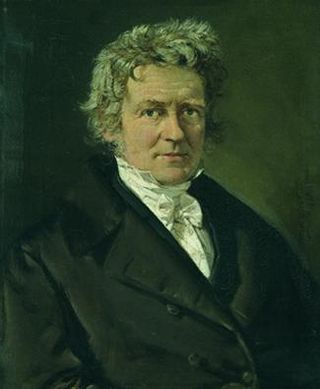
Friedrich Wilhelm Bessel was a German astronomer, mathematician, physicist, and geodesist. He was the first astronomer who determined reliable values for the distance from the sun to another star by the method of parallax. Certain important mathematical functions were named Bessel functions after Bessel's death, though they had originally been discovered by Daniel Bernoulli before being generalised by Bessel.

The Paris Observatory, a research institution of the Paris Sciences et Lettres University, is the foremost astronomical observatory of France, and one of the largest astronomical centers in the world. Its historic building is on the Left Bank of the Seine in central Paris, but most of the staff work on a satellite campus in Meudon, a suburb southwest of Paris.

The Pulkovo Astronomical Observatory, officially named the Central Astronomical Observatory of the Russian Academy of Sciences at Pulkovo, is the principal astronomical observatory of the Russian Academy of Sciences. It is located 19 km south of Saint Petersburg on Pulkovo Heights 75 metres (246 ft) above sea level. It is part of the UNESCO World Heritage Site Historic Centre of Saint Petersburg and Related Groups of Monuments. It was formerly known as the Imperial Observatory at Pulkowo.
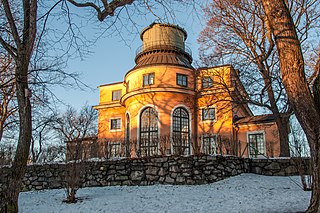
The Stockholm Observatory is an astronomical observatory and institution in Stockholm, Sweden, founded in the 18th century and today part of Stockholm University. In 1931, the new Stockholm Observatory, nicknamed "Saltis", was inaugurated on the Karlsbaderberget at Saltsjöbaden, near Stockholm, and operated until 2001.

The Berlin Observatory is a German astronomical institution with a series of observatories and related organizations in and around the city of Berlin in Germany, starting from the 18th century. It has its origins in 1700 when Gottfried Leibniz initiated the "Brandenburg Society of Science″ which would later (1744) become the Prussian Academy of Sciences. The Society had no observatory but nevertheless an astronomer, Gottfried Kirch, who observed from a private observatory in Berlin. A first small observatory was furnished in 1711, financing itself by calendrical computations.
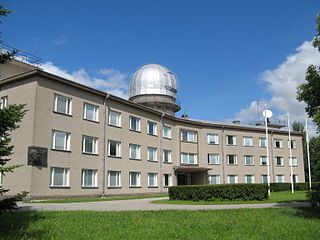
The Tartu Observatory is the largest astronomical observatory in Estonia. On 1 January 2018, Tartu Observatory was joined again to the University of Tartu, and the observatory is now an institute of the university. It is located on the Tõravere hill, about 20 km south-west of Tartu in Nõo Parish, Tartu County. The old Tartu Observatory, located in Tartu city centre, is known internationally for its connection to Friedrich Georg Wilhelm von Struve and the Struve Geodetic Arc, of which it is the first reference point.

Konkoly Observatory is an astronomical observatory located in Budapest, Hungary is part of the Research Centre for Astronomy and Earth Sciences and belongs to the HUN-REN Magyar Kutatási Hálózat. Konkoly Observatory was founded in 1871 by Hungarian astronomer Miklós Konkoly-Thege (1842–1916) as a private observatory, and was donated to the state in 1899. Konkoly Observatory, officially known as HUN-REN CSFK Konkoly Thege Miklós Csillagászati Intézet in Hungarian, is the largest astronomical research institute in Hungary, and hosts the largest telescopes in the country. The Observatory has more than 60 researchers, a quarter of them are non-Hungarian.

The National Observatory of Athens is a research institute in Athens, Greece. Founded in 1842, it is the oldest research foundation in Greece. The Observatory was the first scientific research institute built after Greece became independent in 1829, and one of the oldest research institutes in Southern Europe. It was built around the same period as the United States Naval Observatory.

The Detroit Observatory is located on the corner of Observatory and Ann streets in Ann Arbor, Michigan. It was built in 1854, and was the first scientific research facility at the University of Michigan and one of the oldest observatories of its type in the nation. It was designated a Michigan State Historic Site in 1958 and placed on the National Register of Historic Places in 1973.

Heidelberg-Königstuhl State Observatory is a historic astronomical observatory located near the summit of the Königstuhl hill in the city of Heidelberg in Germany. The predecessor of the current observatory was originally opened in 1774 in the nearby city of Mannheim but degradation of observational conditions there resulted in a relocation to the Königstuhl in 1898.

The Toronto Magnetic and Meteorological Observatory is a historical observatory located on the grounds of the University of Toronto, in Toronto, Ontario, Canada. The original building was constructed in 1840 as part of a worldwide research project run by Edward Sabine to determine the cause of fluctuations in magnetic declination. Measurements from the Toronto site demonstrated that sunspots were responsible for this effect on Earth's magnetic field. When this project concluded in 1853, the observatory was greatly expanded by the Canadian government and served as the country's primary meteorological station and official timekeeper for over fifty years. The observatory is considered the birthplace of Canadian astronomy.

The Kuffner observatory is one of two telescope-equipped public astronomical observatories situated in Austria's capital, Vienna. It is situated in the West of the city's Ottakring district, on the slope of the Gallitzinberg at 302 m altitude. Originally a private research institution, it was converted into an educational astronomy facility after World War II as buildings and city lights had encroached to a degree that severely hampered scientific nightsky observations. Today the main tasks of the observatory consist in public education on astronomy, operating and preserving the historical equipment, and minor projects in scientific astronomy.
Virgilio Trettenero was an Italian mathematician and astronomer born in Recoaro Terme, Province of Vicenza, Italy. Active between 1848–1863, his name is linked to the creation of the stellar catalogs, a work initiated by Giovanni Padovani in 1838 using the meridian circle, which he purchased. The asteroid 16715 Trettenero, discovered on 20 October 1995 at the San Vittore Observatory, in Bologna, was named so in his honour.
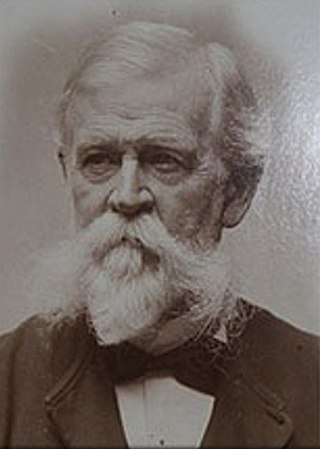
Vasily Pavlovich von Engelhardt was a Russian astronomer, landowner and public figure.
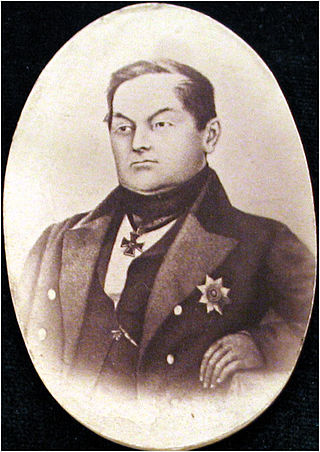
Ivan Mikhailovich Simonov (1794–1855) was a Russian astronomer and a geodesist.

University of Tartu Old Observatory or Tartu Old Observatory is an observatory in Tartu, Estonia. Tartu Observatory was an active observatory from 1810 to 1964. The building now serves as a museum and belongs to the University of Tartu Museum.

Observatory "Kamenskoe Plateau" is an astronomical observatory founded in 1947 at the Fesenkov Astrophysical Institute. In 1948, Gavriil Tikhov headed an independent institution - the astrobotany sector of the Academy of Sciences of the Kazakh SSR - and founded his own observatory. After Tikhov's death in 1960, the astrobotany sector was disbanded. The observatory is located in the grounds of the Fesenkov Institute.

Georgios Konstantinos Vouris (Greek: Γεώργιος Κωνσταντίνου Βούρης; aka Georg Konstantin Bouris was a Greek astronomer, physicist, mathematician, author, and professor. He was a pioneer in 19th-century Greek astronomy. Vouris lobbied tirelessly to create an astronomical observatory in Athens. He was the first director of the National Observatory of Athens. It was completed in 1846. Greece reconnected with its Astronomical roots. It was the first time since antiquity that a country named Greece played a significant role in Astronomy. He was the first author to publish a university textbook in the field of mathematics since the inception of the new country.


















